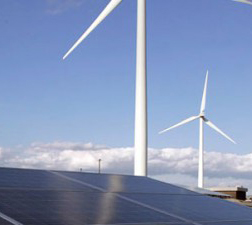Renewables Now Cheaper than Coal in Michigan, Could Be $5-Billion Industry
 New renewable energy generation is now cheaper than new coal generation in Michigan, and could be a $5-billion annual industry for the economically hard-hit state. So say two recent reports analyzing the state’s progress toward renewable energy goals.
New renewable energy generation is now cheaper than new coal generation in Michigan, and could be a $5-billion annual industry for the economically hard-hit state. So say two recent reports analyzing the state’s progress toward renewable energy goals.While both findings are impressive, new renewables falling below the cost of new coal is a more important long-term trend. The analysis comes from a Michigan Public Service Commission (PSC) report detailing implementation costs of meeting the state’s 10 percent renewable energy standard.
Renewables 10% Cheaper Than Coal
New wind, biomass, landfill gas, and hydroelectric generation all cost less than new advanced-supercritical pulverized coal plants with a 40-year life cycle, according to the report. PSC staff estimated in 2009 that electricity generated from new coal plants would cost $133 per megawatt-hour (MWh), and reiterated that estimate, saying “new coal capacity would likely require significant capital costs (and potentially increase rates for customers).”
By comparison, the report finds “the cost of all renewable energy technologies is less than the coal guidepost rate” of $133/MWh, especially in the service territories of the state’s two largest utilities. The combined average levelized renewable energy contract prices for Consumers Energy and Detroit Edison from 2009-2011 are at least $12 cheaper per MWh compared to coal, and “the actual cost of renewable energy contracts submitted to the Commission to date shows a downward pricing trend.”
Competitive Costs Driving Investment
So, not only are renewables cheaper than coal, but that gap is widening, and competitive costs are driving new investment. This trend is shown by the $100 million in advanced energy projects investments the PSC reported between 2008-2011, with 1,000 megawatts of new wind capacity since the RPS took effect.
“Throughout the MISO footprint, increased growth in wind generation appears to have displaced relatively high cost generation, resulting in lower cost base-load plants more frequently setting the marginal electricity price. The continued growth in Michigan’s wind generation is expected to make a much greater contribution to this displacement in the MISO footprint by the end of 2012 as over 800 MW of new wind generation will be operational in the state.”
Key To Long-Term Economic Recovery?
That growth could ultimately wind up being a $4.9-billion annual industry in Michigan, support 20,800 jobs, and generate $163 million in tax revenue by 2015, according to a recent report from the Michigan Energy Innovation Business Council (MEIBC). Those figures could rise even higher, to $6.2 billion and 26,000 jobs, in an ideal scenario, perhaps if the state increased its RPS target to 25 percent by 2025.
Considering manufacturing employment in the state dropped 42 percent between 2001 and 2010, these new clean energy jobs could be exactly what Michigan’s economy and environment needs to thrive in the 21st century.
You can return to the main Market News page, or press the Back button on your browser.

